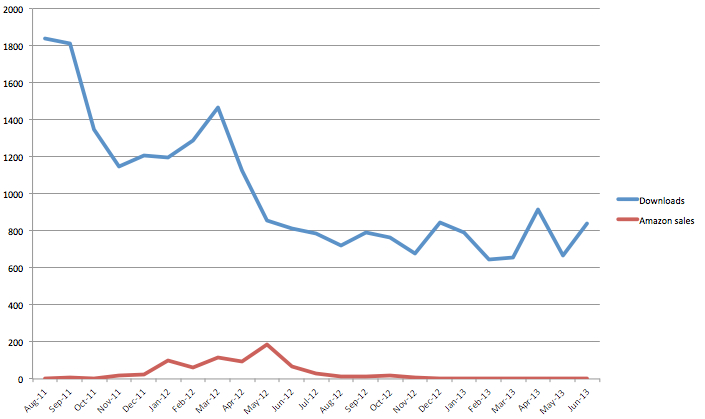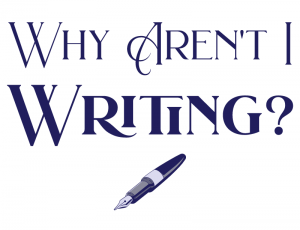I finally sat down and trawled through all my website stats and Kindle sales reports for Argleton, which I published in August 2011 on my website and then the next month on Amazon. The results are interesting, to me at least, because the numbers are far higher than I had anticipated. I counted downloads of the PDF, txt, mobi, ePub and HTML files, all of which were free, and the sales in all Kindle stores where the book was available. I also totted up all the remittances that Amazon sent me, which isn’t a true total as Amazon has minimums for each store that you must cross before it’ll send you your money. There are still a few dollars here and there in various regional stores.
Free Downloads: 23,180
Sales: 782
Remittances: £210.86
That’s actually a lot better than I had anticipated. The price on the Kindle store fluctuated a little, but was generally around the £1.20 – £1.50 mark. My average royalty was 27p per copy.
The graph of sales tells an interesting, if unclear, story:
The free downloads (top line, in blue) behave very much as you might expect, with a big peak at launch followed by a slow ebb in downloads. I’m not sure what caused the peak in March 2012. They then settle down to around the 700 per month mark. It must be said at this point that I don’t know how many of these downloads are from actual people, and how many are from bots and other non-humans. Even if half of them are bots, the numbers are still good.
The Amazon sales could have behaved in one of two ways: an initial surge followed by a decline, or a slow build as the book gained traction with Amazon’s algorithms. The graph begins to show the second pattern, with a slow increase in sales up to a peak of 185 in May 2012. But then, beginning in June 2012 and completed by July, the numbers crash. This co-incided with two events: The book received three 1 star torpedo reviews* that slated the book as being childish, and Amazon changed its algorithm to effectively punish cheap books. It’s impossible to say which event killed my sales, but something did. By early 2013, I’m lucky if I’m selling 5 copies per month.
This is behind my decision to pull Argleton from Amazon and only sell my ebooks direct through this very site. If I’m not going to benefit from Amazon’s much vaunted recommendation engine and have to do all the promotion work myself, then I may as well send people to my own shop. If I control the point of sale, then I can both track where people come from and invite them to join my mailing list when they buy my books. I can’t do that with Amazon and, at the moment, data and subscribers are much more important to me than sales.
Well, I say that, but sales are still very important! I spent £250 on the cover redesign for Argleton, and I’m only 16 full-price sales away from breaking even on it. For Queen of the May, I’ve so far spent £350 on editorial and cover design and I’d very much like to make that back. My new pricing structure is this:
Short story: 99p
Novella: £2.49
Novel**: £3.99
Those prices are higher than I was selling Argleton at on Amazon, but the average reading speed is about 200 words per minute, so it would take over three hours to read Queen of the May — you’d have to be really nursing a glass of wine or pint of beer to make it last that long. And, in this neck of the woods anyway, you’d be lucky to get a drink down the pub for just £2.49 so I think they are reasonable prices. For those of you who love a bargain, I will of course be offering deals via Twitter and my mailing list.
So let’s do the maths: In order to break even on Queen of the May, I need to sell 141 159*** full-price copies. Given I sold 782 copes of Argleton over two years, I feel quite confident that I will sell more than 141 159 copies of Queen of the May, not least because this is a much, much better book than Argleton. It might take a while, but it will happen.
Out of curiosity, I totted up the hours I had spent working on Queen of the May. Ignoring the Kickstarter stuff, I have spent a little over 150 hours writing and editing. We won’t mention that those hours have been spread out, embarrassingly, over nearly two years, but we will say that I’ve been finding it easier to focus on writing recently so I’m hoping my productivity rockets.
If I wanted to be paid minimum wage, ie £6.31 per hour, for the time I’ve already spent writing, then I need to sell 381 429 books, netting me £948.09. And if I want to be paid at a rate high enough for to be able to stop consulting and write full time, I’d need to sell 1000 books per month, or 1071 to cover the time I’ve already invested.
Were I still selling through Amazon at the lower price point that’s expected there, I’d need to sell 8185 ebooks per month to be able to give up other work, a number that seems impossibly high. If I upped my price to £2.49, which would hit the 70% royalty rate, then that number would come down to 1267. I think it’ll take me quite a while to build sales up to 1000 novella-equivalents per month, but it doesn’t seem like a ridiculous number.
I am, of course, excited to see what happens with Queen of the May, now freshly published! I’m literally just waiting for the cover art to arrive and then it’ll be ready to be published. But I’m under no illusions regarding just how much promotional donkey work I’ll have to do, with no Amazon algorithms to rely on or give me a signal boost, just Twitter, my newsletter and you, dear reader. So if you like my writing, please do tell your friends, and tell them to tell their friends.
* It’s worth noting that at least one of the 1 star reviews came from someone who had bought Argleton because it was recommended as an ‘also bought’ on Hugh Howey’s Wool and they were very disappointed that Argleton wasn’t Wool. The two books couldn’t be more different, and it was a rather stark reminder that Amazon’s recommendations engine can cut both ways.
** There is a novel coming, honest.
*** Update: Damn it, I forgot PayPal takes a cut. For every £2.49 you spend, I get £2.21, which is about 88 percent of list price and still better than what I’d get from Amazon. For every 99p you spend, I get 76p, which is about 77 percent of list price, dramatically more than I’d get from Amazon who, at that price point, would give me only a 30% royalty or 23p. All numbers have been adjusted to take that into account.
{ Comments on this entry are closed }





